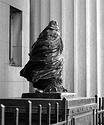cooltouch
Member
This roll I just developed is the first time I've ever used Tri-X professional 400TX. Based on the looks of about half of the negs, I think I'm really gonna like this stuff. But the other negs showed symptoms of something I did wrong, and I'm hoping to get some feedback on that from you.
The camera is a Yashica Mat 124. So film advances vertically, and the sides of the frames are the edges of the roll.
This image was the second image on the roll. It and all the other images were exposed based on meter readings from a meter of known accuracy.

The first four or so images are all on the outside ring of the reel, and they all show similar streaks. The above image shows some slight bright spots along the right edge; the third image shows more pronounced bright patches along the right edge.
This next image was the last frame of the roll. Note the light patch over the engine area, and the streaks to the right of the frame. It's almost as if, after a more or less normal group of frames, the oddball stuff is returning. Which seems kinda odd to me, though, since this frame would have been the inner-most on the reel.

And finally, here's a shot from about the middle of the roll. Normal negative density. Rather nice and smooth gradations between light and shadow, good shadow detail. The only trace of a bit of abnormality is some lightness toward the right edge of the frame.

Okay, now that you've seem some images, I should state that, right off the bat, I blew it. I got ahead of myself, and started pouring the D-76 into the tank before I started my stopwatch. So, I was trying to keep an approximate running count in my head after finishing with pouring, then tapping the tank, then rinsing off my hands before switching my cell phone over to its stop watch mode. Dang handy things, these modern cell phones. I figured roughly 45 seconds went by.
At 70F and full strength, the Kodak data sheet shows that D-76 should be used for 6 minutes, 15 seconds. So when I started my stopwatch I figured that 5:30 were remaining. All I could hope was that I was close. But would being off by a few seconds cause the streaks? And what about the light(er) areas along the right side of the frames? I was careful to premeasure both the developer and the fixer before pouring them into the tank, so I'd be sure to have enough.
I use an old Yankee tank for developing B&W -- have used one for years. It's the type that has the plastic reel where each half of the reel is rocked back and forth to advance the film onto the spool. And it has the spinner that doubles as a thermometer used for agitation (although I have a better thermometer for temperature measurement chores).
So anyway, as I always do, I spin the reel for about 5 seconds out of every thirty seconds, back and forth, back and forth.
I also have never used a stop bath. I'll usually just run water through the tank for a few minutes, drain, then add the fixer. As for the fixer, it's just plain old Kodak Fixer, and I used it for about 7:30, which is about what I always do, and which is about what the 400TX data sheet recommends.
So, what I'm getting at is, apart from not timing my development time accurately, everything else about the process went the way it always does.
Got any suggestions?
The camera is a Yashica Mat 124. So film advances vertically, and the sides of the frames are the edges of the roll.
This image was the second image on the roll. It and all the other images were exposed based on meter readings from a meter of known accuracy.

The first four or so images are all on the outside ring of the reel, and they all show similar streaks. The above image shows some slight bright spots along the right edge; the third image shows more pronounced bright patches along the right edge.
This next image was the last frame of the roll. Note the light patch over the engine area, and the streaks to the right of the frame. It's almost as if, after a more or less normal group of frames, the oddball stuff is returning. Which seems kinda odd to me, though, since this frame would have been the inner-most on the reel.

And finally, here's a shot from about the middle of the roll. Normal negative density. Rather nice and smooth gradations between light and shadow, good shadow detail. The only trace of a bit of abnormality is some lightness toward the right edge of the frame.

Okay, now that you've seem some images, I should state that, right off the bat, I blew it. I got ahead of myself, and started pouring the D-76 into the tank before I started my stopwatch. So, I was trying to keep an approximate running count in my head after finishing with pouring, then tapping the tank, then rinsing off my hands before switching my cell phone over to its stop watch mode. Dang handy things, these modern cell phones. I figured roughly 45 seconds went by.
At 70F and full strength, the Kodak data sheet shows that D-76 should be used for 6 minutes, 15 seconds. So when I started my stopwatch I figured that 5:30 were remaining. All I could hope was that I was close. But would being off by a few seconds cause the streaks? And what about the light(er) areas along the right side of the frames? I was careful to premeasure both the developer and the fixer before pouring them into the tank, so I'd be sure to have enough.
I use an old Yankee tank for developing B&W -- have used one for years. It's the type that has the plastic reel where each half of the reel is rocked back and forth to advance the film onto the spool. And it has the spinner that doubles as a thermometer used for agitation (although I have a better thermometer for temperature measurement chores).
So anyway, as I always do, I spin the reel for about 5 seconds out of every thirty seconds, back and forth, back and forth.
I also have never used a stop bath. I'll usually just run water through the tank for a few minutes, drain, then add the fixer. As for the fixer, it's just plain old Kodak Fixer, and I used it for about 7:30, which is about what I always do, and which is about what the 400TX data sheet recommends.
So, what I'm getting at is, apart from not timing my development time accurately, everything else about the process went the way it always does.
Got any suggestions?
Last edited by a moderator:





 ), but when I first started out, I didn't agitate enough, and got marks similar to yours shown here. Simple answer: Go on ebay or craigslist, and get yourself a tank(Paterson w/ Rubber lids=fast pour-in/out times vs. stainless lids) and plop down $10-$15, probably less. Add a stainless reel or two(if you shoot 35mm as well), and you're set. Some People also use a water bath pre-soak before development, it helps to swell the emulsion, and I've found I have less mottling issues(none now), after using a stainless tank(Paterson) or Jobo tank, pouring quickly, and agitating for the first 30s. Some don't do the pre-soak, its up to you, doesn't hurt though to try on a roll or two.
), but when I first started out, I didn't agitate enough, and got marks similar to yours shown here. Simple answer: Go on ebay or craigslist, and get yourself a tank(Paterson w/ Rubber lids=fast pour-in/out times vs. stainless lids) and plop down $10-$15, probably less. Add a stainless reel or two(if you shoot 35mm as well), and you're set. Some People also use a water bath pre-soak before development, it helps to swell the emulsion, and I've found I have less mottling issues(none now), after using a stainless tank(Paterson) or Jobo tank, pouring quickly, and agitating for the first 30s. Some don't do the pre-soak, its up to you, doesn't hurt though to try on a roll or two.